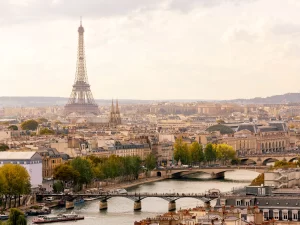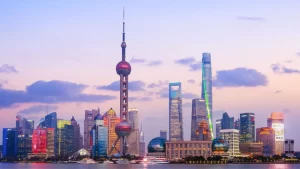From the dawn of civilization, humanity has strived to reach the skies. With every stone placed atop another, with every structure that’s scraped the heavens, mankind has expressed not just architectural prowess but also an inherent need to make our mark upon the world.
Skylines—these vast canvases of concrete, steel, and glass—speak of our journey as a species and every city tells a tale of time.
This seamless blending of the old with the new is a testament to our respect for the roots from which we’ve sprung and our dreams of the future we yearn to mold.
As we travel through these iconic cities and gaze up at their skylines, we’re not just witnessing architectural marvels. We’re stepping into stories, legacies, and visions. We’re seeing the brilliance of human imagination, the enduring ambition, and the spirit of communities that have risen, rebuilt, and reimagined their spaces through the annals of time.
Paris, France
Paris, often referred to as “The City of Light”, is known more for its historic architecture than its skyscrapers. The skyline is dominated by the Eiffel Tower, which stands at 324-meters tall and made of iron. It was constructed in 1889 as the entrance arch to the 1889 World’s Fair.
While Paris is home to some modern high-rises in the La Défense district, strict regulations ensure that most buildings in the central city are not too tall, preserving the city’s historical charm.
Notre-Dame Cathedral, the Louvre, and the Sacré-Cœur are among its oldest and most iconic structures. The low-rise Parisian skyline is a symbol of romance, art, and European sophistication.
Hong Kong, China
Hong Kong boasts one of the most breathtaking skylines in the world, with a jaw-dropping juxtaposition of modern skyscrapers backdropping verdant mountains and the sparkling harbor.
The city is home to over 300 skyscrapers, more than any other city in the world. Two of its most iconic towers are the International Commerce Centre and the Bank of China Tower.
The nightly “Symphony of Lights” show illuminates the skyline, making the harbor a dazzling spectacle. This densely packed collection of steel and glass is a testament to the city’s commercial success and its position as a global financial hub.
New York, USA
New York’s skyline is, without a doubt, one of the most recognizable in the world. Home to iconic structures like the Empire State Building, One World Trade Center, and the Chrysler Building, the city’s skyline tells the story of 20th-century architecture and its evolution.
The city has over 200 skyscrapers in total, with the densest concentration occurring in Manhattan. The juxtaposition of Central Park against the massive high-rises offers a unique blend of urban and natural vistas. New York’s skyline is not just an architectural feat but also a symbol of American ambition and resilience.
Rio De Janeiro, Brazil
Rio’s skyline is renowned not necessarily for its skyscrapers but for the stunning natural setting in which the city is situated. Sandwiched between lush mountains and the azure sea, Rio’s cityscape is overlooked by the iconic Christ the Redeemer statue that stands atop the Corcovado mountain.
The Sugarloaf Mountain (Pão de Açúcar) is another natural monument that adds to the city’s dramatic skyline. While Rio has its share of urban development, it’s the harmonious blend of nature and city, beach and mountain, that makes its skyline genuinely unique and recognizable worldwide.
Shanghai, China
Shanghai’s skyline, particularly the Pudong district, is a symbol of China’s rapid modernization and economic growth. Dominated by towering structures like the Shanghai Tower (the third tallest building in the world), the Oriental Pearl TV Tower, and the Jin Mao Tower, the city’s skyline reflects its status as a global economic powerhouse.
The Bund, located on the opposite side of the Huangpu River, offers a stark contrast with its historical colonial-era buildings. At night, the illuminated skyline along the river is nothing short of magical, showcasing Shanghai’s blend of the historic and the ultra-modern.
Sydney, Australia
Sydney’s skyline is immediately recognizable due to the architectural wonder of the Sydney Opera House, which is known for its iconic sail-like structures, and the steel arch of the Sydney Harbour Bridge.
Nestled around Sydney Harbour, the city has a mix of historic buildings and modern skyscrapers, reflecting its colonial heritage and status as a contemporary global city.
The skyline, viewed from points like Mrs Macquarie’s Chair or from the ferry services in the harbour, offer a picturesque blend of urban development set against natural beauty.
Kuala Lumpur, Malaysia
Kuala Lumpur is home to the iconic Petronas Twin Towers, which were the tallest buildings in the world from 1998 to 2004. These gleaming structures remain the tallest twin towers to this day. The city’s skyline, while dotted with numerous skyscrapers, also showcase elements of Mughal architecture, reflective of Malaysia’s cultural heritage.
The juxtaposition of old and new can be seen throughout the city, with historic mosques and temples standing proudly amidst modern high-rises. Kuala Lumpur’s skyline is a testament to the country’s rich history and its ambitious stride towards the future.
Istanbul, Turkey
Istanbul’s skyline is a mesmerizing blend of ancient and modern architecture. The city’s silhouette is dominated by historic structures such as the Hagia Sophia with its majestic dome, the Blue Mosque with its cascading domes and minarets, and the towering Galata Tower.
The Bosphorus Strait adds a unique maritime element to the cityscape. In contrast, newer districts like Levent and Maslak showcase modern skyscrapers and business centers, symbolizing Turkey’s growing economic influence.
Dubai, United Arab Emirates
Dubai’s skyline is a testament to human ambition. Home to the Burj Khalifa, the tallest structure and building in the world, Dubai showcases a forest of skyscrapers in its downtown area, each vying for a unique stance in the architectural realm.
The city has become synonymous with luxurious living and futuristic architecture, with structures like the sail-shaped Burj Al Arab and the twisting Cayan Tower.
From a sparse desert landscape to a metropolis of towering skyscrapers within a few decades, Dubai’s skyline is ever-evolving and reflects the emirate’s rapid transformation and vision for the future.
London, UK
London’s skyline boasts a rich tapestry of history and modernity. The historic Tower Bridge, the Tower of London, and the Houses of Parliament with the iconic Big Ben tell tales of a city steeped in history.
In contrast, newer additions like The Shard, the Gherkin, and the Walkie-Talkie building showcase London’s contemporary architectural ambitions. The River Thames, winding its way through the city, adds a reflective element to this diverse cityscape.
London’s skyline, while continually evolving, remains rooted in its deep historical significance, representing its status as a global city that bridges the old world with the new.
So there we have it, our picks for the 10 most iconic skylines in the world. Do you agree with our picks? Think we’ve missed one? Let us know in the comments below!










